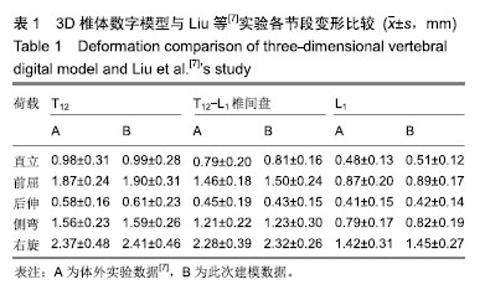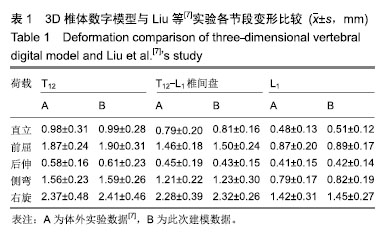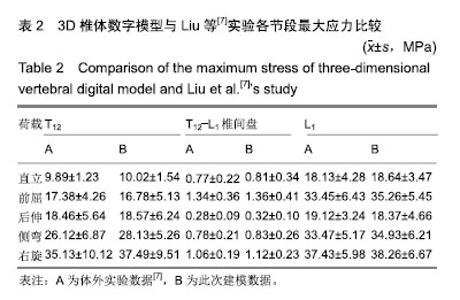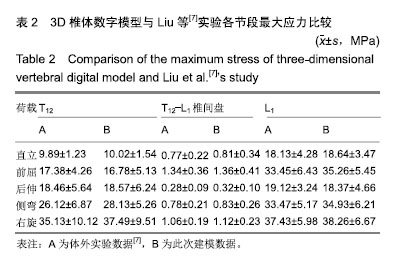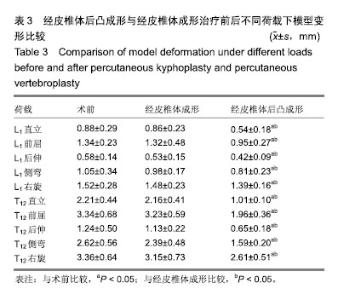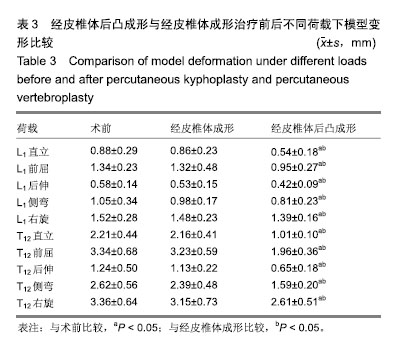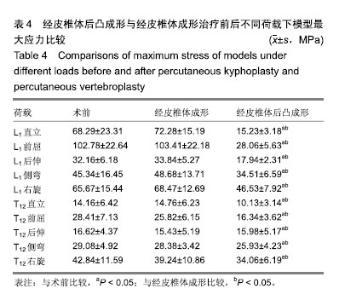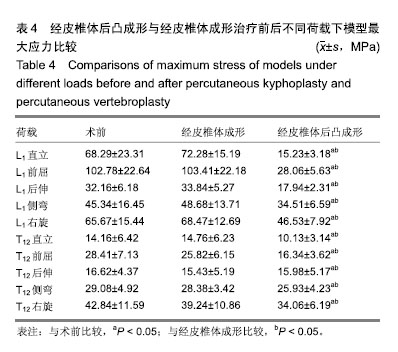| [1]笪巍伟,唐德志,舒冰,等.原发性骨质疏松症及椎体压缩性骨折的防治进展[J].广东医学,2016,37(11):1714-1717.[2]Wang H, Sribastav SS, Ye F, et al. Comparison of percutaneous vertebroplasty and balloon kyphoplasty for the treatment of single level vertebral compression fractures: a meta-analysis of the literature. Pain Physician. 2015; 18(3):209.[3]粟迎春.经皮椎体成形术和经皮椎体后凸成形术治疗骨质疏松性椎体压缩骨折的疗效[J].实用医学杂志,2017,40(2):74-75.[4]宋仁谦,周英杰,赵刚,等.高黏度骨水泥经皮椎体成形术与经皮椎体后凸成形术治疗骨质疏松压缩骨折的临床疗效观察[J].中国矫形外科杂志,2016,24(8):692-696.[5]王健,李凯,陈博,等.胸腰椎体压缩性骨折三维有限元模型的建立和分析[J].中国矫形外科杂志,2016,24(16):1498-1503.[6]Nakashima D, Kanchiku T, Nishida N, et al. Finite element analysis of compression fractures at the thoracolumbar junction using models constructed from medical images. Exp Ther Med. 2018;15(4):3225-3230.[7]Liu Y, Xu J, Sun D, et al. Biomechanical and finite element analyses of bone cement‐Injectable cannulated pedicle screw fixation in osteoporotic bone. J Biomed Mater Res B Appl Biomater. 2016104(5):960-967.[8]崔志刚,张德光,刘福全.PVP与PKP治疗骨质疏松性胸腰椎体骨折的疗效对比[J].重庆医学,2017,46(21):2971-2974.[9]Hedayati Z, Shomali M. Maxillary anterior en masse retraction using different antero-posterior position of mini screw: a 3D finite element study. Prog Orthod. 2016;17(1):31.[10]El-Anwar M, Ghali R, Aboelnagga M. 3D finite element study on: bar splinted implants supporting partial denture in the reconstructed mandible. Open Access Maced J Med Sci. 2016; 4(1):164-171. [11]王吉博.有限元法评估经皮椎体成形和后凸成形治疗脊柱三明治骨折的生物力学变化[J].中国组织工程研究,2017,21(35):5703-5708.[12]Shamami DZ, Karimi A, Beigzadeh B, et al. A 3D finite element study for stress analysis in bone tissue around single implants with different materials and various bone qualities. J Biom Tissue Eng. 2014;4(8):632-637.[13]林娟颖,刘晓颖,邢立杰,等.基于有限元法的跟骨生物力学分析[J].医用生物力学,2018,33(1):37-41.[14]周伟,刘贵省,周丽萍,等.不同方式灌注骨水泥治疗骨质疏松性椎体压缩骨折的比较[J].中国组织工程研究, 2017,21(14):2147-2152.[15]Cheong VS, Blunn GW, Coathup MJ, et al. A novel adaptive algorithm for 3D finite element analysis to model extracortical bone growth. Comput Methods Biomech Biomed Engin. 2018; 21(2):129-138.[16]张立峰,张元智,华子恺,等.髋臼前柱顺行拉力螺钉固定钉道的设计及有限元分析[J].中华骨科杂志,2017,37(5):276-283.[17]潘元星,米川,施学东,等.经皮椎体成形术治疗多发性骨髓瘤患者椎体多发病理骨折44例临床分析[J].解放军医学杂志,2016,41(11): 945-948.[18]高琨,杨隆秋,胡美琴,等.脊柱微创术治疗症状性椎体血管瘤合并腰椎间盘突出症[J].中国矫形外科杂志,2018,26(21):2003-2006.[19]李大明,徐丽军.经皮椎体成形术治疗老年骨质疏松性胸腰椎压缩性骨折的疗效[J].重庆医学,2017,2(46):322-324.[20]李坤,梅继文,胡守力,等.PVP联合RFA对骨质疏松性椎体压缩性骨折患者术后疼痛及生活质量的影响[J].山东医药,2017,57(46): 83-85.[21]马俊. 经皮椎体后凸成形术与经皮椎体成形术治疗骨质疏松椎体压缩骨折的疗效比较[J].中国矫形外科杂志,2017,25(6):571-573.[22]许正伟,贺宝荣,郝定均,等.胸腰椎骨质疏松性骨折经皮椎体成形术后骨水泥渗漏的研究进展[J].中华骨科杂志,2016,36(17): 1142-1148.[23]唐冲,吴四军,刘正,等.高粘度骨水泥经皮椎体成形术治疗骨质疏松性椎体压缩骨折的疗效分析[J].中国脊柱脊髓杂志,2017,27(8): 720-726.[24]Feng L, Feng C, Chen J, et al. The risk factors of vertebral refracture after kyphoplasty in patients with osteoporotic vertebral compression fractures: a study protocol for a prospective cohort study. BMC Musculoskelet Disord. 2018;19(1):195-202.[25]李穗鸥,杨波,尹飚,等.经皮椎体成形术或经皮后凸成形术治疗合并脊柱侧凸的脊柱压缩性骨折[J].中国微创外科杂志,2018,18(3): 244-248.[26]包拥政,祝周兴,冯云升,等.低弹性模量骨水泥对骨质疏松压缩性骨折椎体及邻近椎体应力的影响:三维有限元分析[J].中国组织工程研究,2016,20(16):2285-2293.[27]唐勇涛,魏思奇,吴长军,等.PKP不同增强方式对相邻椎体结构生物力学影响的有限元分析[J].中国骨科临床与基础研究杂志,2017, 9(3):167-174.[28]王志鹏,张晓刚,赵文韬,等.有限元分析在腰椎手法治疗中的生物力学研究进展[J].医用生物力学,2017,32(3):293-298.[29]Sharma A, Sargar K, Salter A. Temporal evolution of disc in young patients with low back pain and stress reaction in lumbar vertebrae. Ajnr Am J Neuroradiol. 2017; 38(8):1647-1652.[30]郭秀珍,高斌礼,林森,等.基于PVP和PKP的脊柱骨折的有限元生物力学研究[J].基因组学与应用生物学,2018,37(2):497-504. |
